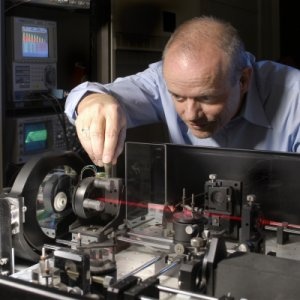 A bald guy adjusting laser optics |
A key aspect in realizing higher recording speeds is the development of a suitable 'writing strategy' - the timing and power of the laser pulses in such a way that marks (representing digital zeros and ones) of the correct length are created in the organic dye that forms the active layer of recordable DVDs. Doing this well becomes increasingly difficult at higher recording speeds, because the available time to heat up and cool down the dye at the position of a mark becomes ever shorter. Especially avoiding that post-heating partly erases a written mark when a neighbouring mark is written is a challenging task. Philips has developed an efficient write strategy that not only results in accurate recording results, but in addition needs only a limited number of parameters to realize it, allowing disc-drive manufacturers to implement the algorithm in a straightforward manner.
Besides the write strategy, improvements on the recorder set-up were needed to realize recording at 16x speed. Especially the design of an accurate and stable system for tracking and focusing the laser beam to the right position on the disc was challenging. Another demanding task was the development of fast laser driving electronics, which runs at a 420 MHz clock at 16x DVD speed. Furthermore, a prototype high-power laser was utilized to achieve the recording power needed. Finally, Ricoh provided the DVD dye discs for the recording experiments.
Read all about it in the Philips press release
Written by: Jari Ketola @ 12 Nov 2003 13:52
